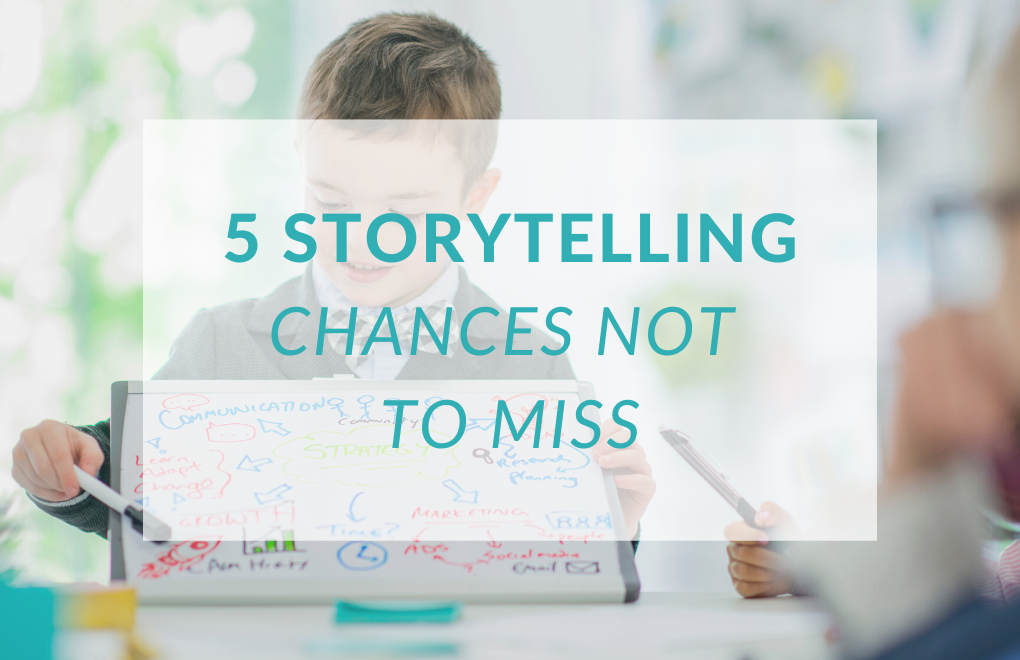By now, everyone knows the power of stories. But are you and your team fully leveraging these five chances of storytelling?
Facts tell, stories sell.
The old adage hasn’t escaped anyone these days, as storytelling remains one of the most performing content marketing and communication trends.
And for good reason: stories instinctively catch our audience’s attention (and keep it), they speak both to reason and emotion and make our message memorable. All are crucial factors when spreading the word about your business in the hectic digital world where an average attention span resembles that of a 2-year-old (I’ve had one, so I should know).
Have you leveraged every chance for storytelling there is in your communication and content marketing? Here are five opportunities not to miss (and a storytelling formula that makes implementing the advice as easy as luring the said toddler’s attention with a smartphone).
1 – About Us Page
Let’s start with one of the most powerful places to share a story that makes your ideal clients immediately connect with your company and service.
No, I’m not talking about the sales deck, I’m talking about something much more powerful and neglected: the About Us page on the company website.
Too often, a company’s About Us page is an endless litany of years and details that only the keenest historians will have the persistence to crawl through. If not that, another commonly adapted option is to stuff together some thinly veiled humble bragging: all the awards won since the 1970s, certifications, letter combinations and titles that would require a master’s degree’s worth of studies to fully understand.
Instead, tell a simple story of why the company was built: What is the problem you were born to solve and what is your vision of the future?
Don’t know how? Download my 6-step template below and check these examples for inspiration!
The Pricing Lady – The red thread throughout her story stays focused on how her experience serves her clients, highlighted with design tricks that make reading easy.
HubSpot – Copy their clever use of a video and visual design to communicate both the mission and the impact of the company.
2 – Social Media About Section
Another crucial piece of storytelling happens on your company’s most important social media profiles. While the content can follow along the lines of the website “About Us”, there are a few key differences to take into account:
- Social media introduction needs to fit within the (often tight) character limits of the platform, so squeeze what’s essential into the space you’ve got.
- Be clear about the strategy and the client journey you want to create and polish the calls to action accordingly.
- Visual highlights and design options are often limited, which requires precise storytelling that won’t let the audience fall into other temptations on the internet.
How about modelling yours after these two?
parents@work – The company’s LinkedIn page rallies readers behind their mission with their enthusiasm and the clarity of their vision.
Write Medicine – An admirably clear definition of both the audience the page serves and the content they can expect.
How to update yours, step by step
3 – Service or Offer Page
What does storytelling have to do with your sales or offer pages? More than anything!
No one likes to be sold to. A sales or offer page without a story behind it is like one of those cold-calling insurance salespeople who tend to call right when you’re in the middle of a delicious meal or an even-more-delicious writing flow.
Sales pages, service pages and landing pages are a place to integrate the story of your client’s pain points and how your service can liberate them from that.
Don’t take my word for it, though. Look how some real masters do it:
Amy Porterfield’s Digital Course Academy Landing Page – A lot of content but laid out in a way that’s easy to follow, taking the reader effortlessly from their most painful struggle to an easy solution in a few steps.
Melitta Campbell’s Business Coaching Page – A masterpiece in value-focused storytelling and testimonials to back it up.
4 – Articles, Reports and Case Studies
Blog articles, reports and case studies are all prime terrain for storytelling. Being long-form pieces, they also allow for experimenting with different structures.
If you’re just getting started with storytelling, try the Status Quo – Change – Outcome structure, which is perfect for case studies, for example.
- What did a client struggle with before working with you or trying your product?
- How did you collaborate or which product did they try?
- What changed for them afterwards?
Pathos Communications – These guys know how to keep the case study process authentic and easy for the team!
5 – Social Media Post
Every piece of content can – and should – be a mini-story! The basic storytelling formula lends itself to each piece of text, audio or video from a social media snippet to white papers and ebooks.
Look for the transformations that happened, pain points that were overcome, milestones that were reached, and others to be achieved in the future, and keep turning your every word into a part of your brand’s story.







Recent Comments